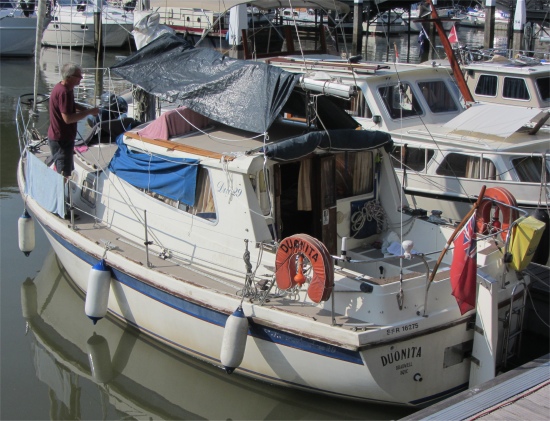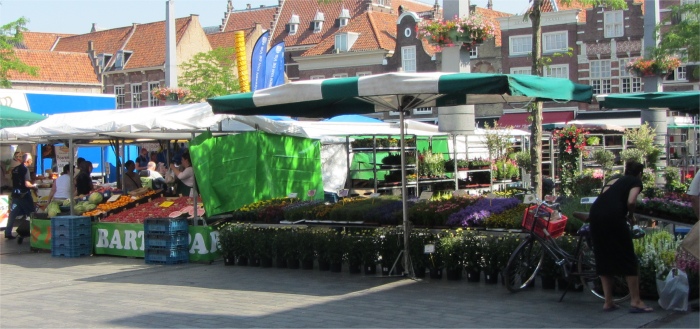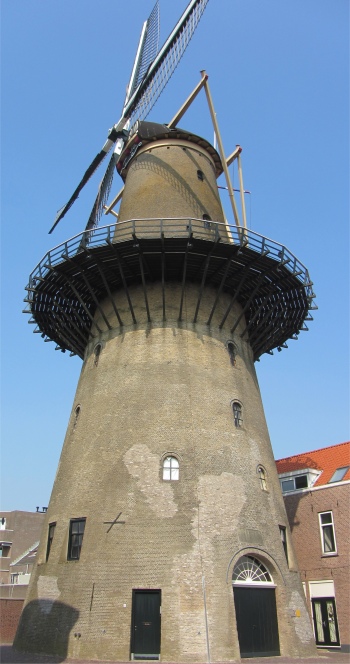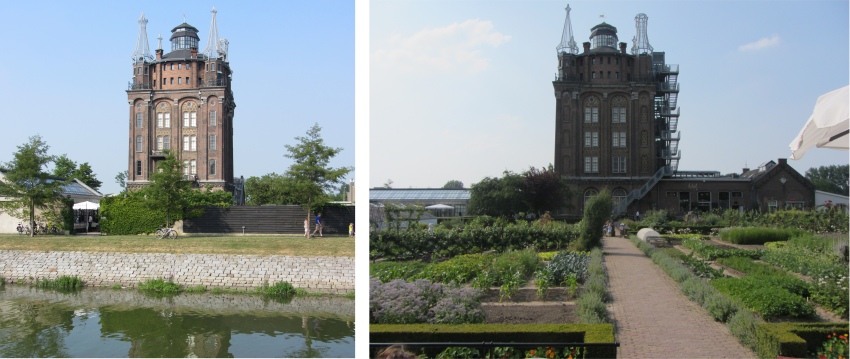 Rex Lovingly Attending to His Floating Shanty Town Creation |
Rex persistently continued in his endeavours to keep the direct sunlight off Duonita. Locals and tourists from every nation on the planet were gathering around to marvel at the evolving floating shanty town that he was creating. I was anticipating hordes of charities and NGOs coming alongside to donate even more sheets of material to help him shade the decks. Nothing could deter him from his mission to create a sub-arctic environment within the cabin. I was expecting frostbite symptoms to strike any day now. However, despite Rex's best endeavours, he had only managed to reduce the cabin temperature to 28 degrees by 10am.
Fortunately my attention was seized by a noise on the quayside, where a regular sized black litter bin stood on a metal sheet surround. These litter bins had a small red flap on the side that could be opened by dog owners allowing them to deposit their small plastic bags of dog poo. A larger sliding flap sat on top of the litter bin, which could only be opened by a token card; obviously a communal bin for the use of local residents only. The noise emanated from a rubbish wagon that had come alongside the bin and parked. Robotic arms appeared out of the side of the vehicle, and tilted the bin with its hinged metallic sheet on which it was based. Then, totally automatically, another set of arms appeared out of the truck, and descended into the void below where the bin had stood. Slowly, a very large container was lifted out of a cavity in the ground, and its contents were poured into the rubbish cart. Then, again completely automatically, the huge container was returned to the void, and the litter bin restored to its rightful place. The truck then proceed to its next port of call.
 Rubbish Wagon Automatically Retrieving Subterranean Rubbish Container |
Our objective this morning was the Museum het Hof, which was still being assembled when we were here the previous year. The two ladies on the reception desk were very welcoming and quite amusing, and I was quite impressed when one of them detected my northern accent. They were pleasantly surprised when they discovered Rex and I spoke a smattering of Dutch. "You know more Dutch than my husband," said one. "That's a coincidence," I replied, "last year we visited the house of Simon van Gijn, and one of the ladies who worked there had a Scottish husband who had never learnt Dutch." The receptionist burst out laughing, her husband was Scottish too. We seem to keep coming across combinations of Scottish husbands and Dutch wives on our adventures across the Netherlands.
 A Dash of Colour in a Corner of Statenplein Market |
 Grand Nursery Entrance |
The museum presented an impressive new multimedia experience that took us from the Middle Ages until now. On the basis of six themes. The story begins with the Golden Age of the early 15th century Dordrecht, moving on to the notorious Saint Elizabeth's flood in 1421 during which the Biesbosch was formed, the guilds and the city government in the 16th and 17th centuries, the First Free State Assembly, the Synod of Dordrecht, which launched the Bible, and industrialisation during the 19th and 20th centuries. Included were a fine selection from the extensive collection of historical paintings and objects interspersed with interactive applications using the latest digital technology employing touch screens, projections and films, resulting in a completely innovative way of showing and experiencing history. Of particular note was a short film which gave a good account of the Synod that met to draw up the stance Holland would take against the Spanish intruders.
A cool refreshing drink was in order at the Groothoofd by the confluence of the three rivers: Oude Maas, Noorde and Beneden Merwede. Sheltering from the glaring sun, I sipped ginger ale while Rex indulged in coffee plus tap water, his latest craze, as we chatted and watched the huge barges and water buses. The ever present speed boats sped by close to the quayside, their skippers adopting laid back posing stances and glinting teeth on display, similar to the dental workers in Kortgene, as they glanced in our direction. Were we impressed? Not a bit.
 Kyck over den Dyck |
I started to follow the Spuihaven around, stopping off at the tourist information office, where I enquired about good suggestions for restaurants. Since Meryl was arriving the next day, we wanted to treat her to a good meal in a pleasant environment on the evening of her arrival. The helpful assistant recommended three. One was at the Groothhoofdpoort which we had visited last year. The second was at Dordrechts Museum, and the third was at Villa Augustus, more or less on the outskirts of the Biesbosch.
As I followed the waterway around, the water became more a weed choked paradise for ducks rather than a waterway. When I got as far as the Noordendijk, I decided to strike east to the Villa Augustus just to check it out, passing Molen "Kyck over den Dyck" on the way. Originally built in 1612, it is the only preserved mill of the city. This mill ground malt, which served as raw material for the Dordrecht brewers, and since 1739 it was used for grinding corn. After a thorough restoration from 1999 to 2001, the mill grinds again on Saturdays operated by a circle of volunteers, and can be rented for parties and meetings.
Once past the Energiehuis, I caught a glimpse of the Villa, an impressive looking building, a structure resembling a castle arising on a strip of land almost surrounded by water. It served at one time as a water tower. One day in 2003 a couple of enterprising people set eyes on a picture of the building in the City Hall. It immediately triggered their imagination. They realised that the water tower was still there, although not in use anymore. They had a vision of this beautiful water tower being put to a new use. A hotel for instance. Imagine sleeping in a former water supply! The surrounding premises, that once had been water, could be turned into water again, recreating the original situation with room for the river Vlij to flow once more. The more recent pumping station that was built in 1942 could be a fitting location for a restaurant and market-cafe.
Where the water basins for the water tower were located, a garden was created. This was a garden for fresh produce, a garden full of berries, a hothouse for grapes and a greenhouse. The entrance to the Villa Augustus was through the Market-Cafe that housed a bakery that produced sourdough bread, cookies, cakes and pies. Almost everything used in the Villa was for sale at the Market: fresh bread, pies, jams, vegetables, flowers, wine, olive oil, tableware, home-made pasta, books and so on.
 Villa Augustus |
On the hike back, I passed by the Dordrechts Museum Restaurant. Hundreds of wedding guests were pouring in, collecting glasses of fine wine as they entered, and assembled in excited small groups in the museum grounds. I didn't even attempt to enter.
In the evening Rex and I sipped a couple of beers in the Scheffersplein before enjoying a pleasant meal in the Eetcafe de Passant just about 100m away from the boat. We had dined here the previous year. The waitress was very appreciative of Rex's mastery of Dutch, judging by the peals of laughter she was making. It must be the way he tells them.
